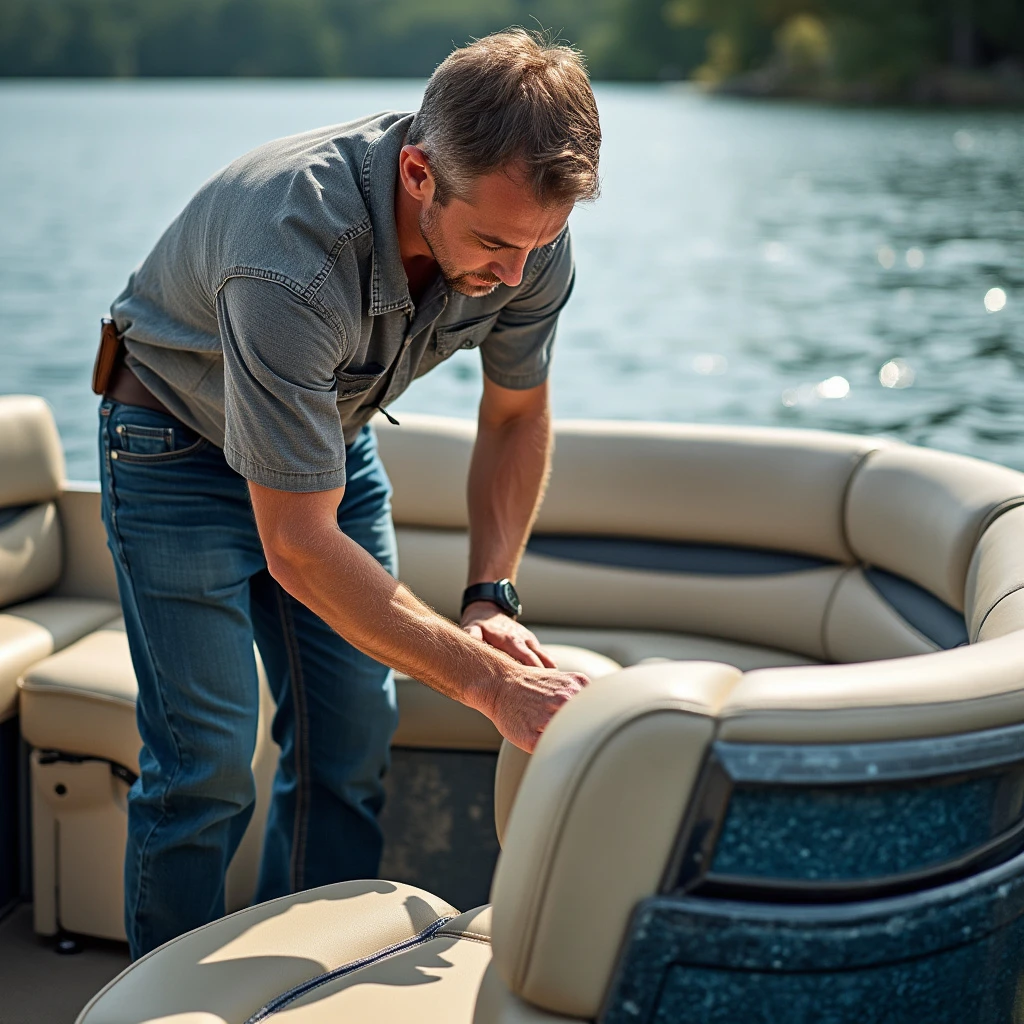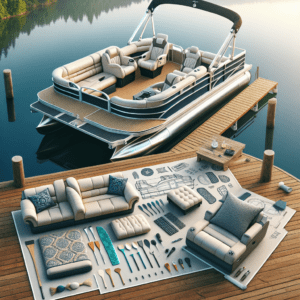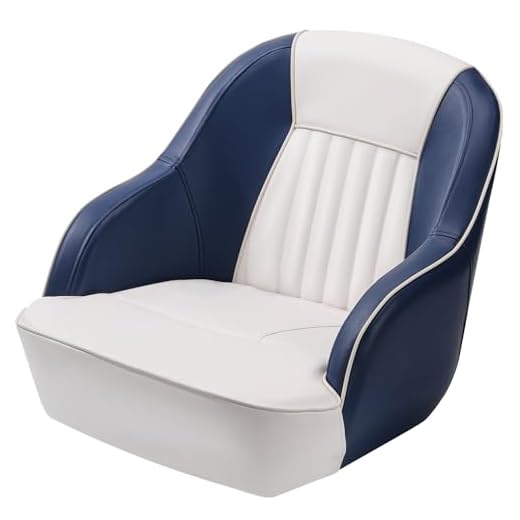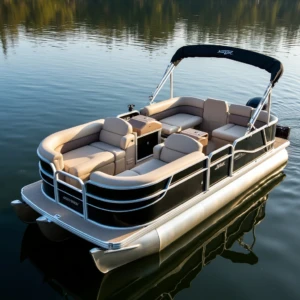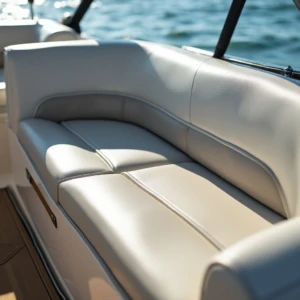Replacement Seats on Your Pontoon
Pontoon replacement seats are a vital component to ensure a comfortable and enjoyable boating experience. Old or damaged seats can cause discomfort and even injury. Therefore, it’s crucial to identify the signs of wear and tear on your pontoon seats before your next boating trip.
1. Identifying Signs of Wear and Tear
Seats that are cracked, torn, or faded are clear indications that they need replacement. Poorly cushioned or sagging seats are also signs that it’s time for an upgrade. If your seats have exposed foam or loose hardware, it’s best to replace them to avoid any hazardous situations.
2. Impact of Comfortable Seating on Your Boating Experience
Poor seating can make your boating experience unbearable. Comfortable seating can allow you to enjoy the time spent on the water, with your loved ones. The right seats can help you maintain optimal posture, reducing the risk of discomfort and back pain after long hours on the water.
3. The Benefits of Upgrading Your Pontoon Seats
Upgrading your pontoon replacement seats is a wise investment. New seats can add value to your boat, making it more appealing and comfortable not just for you but for future owners as well. The process of upgrading can also increase your knowledge about your boat and its parts.
Types of Pontoon Replacement Seats Available
As you consider replacing the seats in your Pontoon boat, there are several options to choose from. Below are some of the common types available:
Bench Seats vs. Captain’s Chairs: Pros and Cons
One of the main considerations to keep in mind when choosing between bench seats and captain’s chairs is the space you have available on your pontoon. Bench seats are ideal for those who need to seat several people or prefer a more economical option, whereas captain’s chairs are more comfortable and provide ergonomic designs that support back health and reduce fatigue.
Wise 8WD100-1B-204 Deluxe Series 37" Pontoon Bench Seat Base Only (8WD100 Cushion Required to Complete), White
| Bench Seats | Captain’s Chairs |
|---|---|
| More economical | More comfortable |
| Ability to seat several people | Ergonomic design that supports back health and reduces fatigue |
Goplus Captain Bucket Seat, Pontoon Boat Seats w/Waterproof PVC Leather & Thick Sponge Padding, Curve Armrest, High Back Boat Captain Chair for Fishing Boat Sightseeing Boat (1 Pack Ivory & Gray)
Specialty Seats: Fishing, Loungers, and More
If you have specific uses for your pontoon, such as fishing or lounging, there are seats designed to accommodate those needs. Fishing seats are designed to be sturdy and durable, with features like rod holders and built-in tackle boxes. Loungers are perfect for those who want to relax and soak up the sun. These specialize seats offer comfortable cushioning and back support to make your experience more comfortable.
- Fishing seats are sturdy and durables
- Loungers offer comfortable cushioning and back support
- Fishing seats have features like rod holders and built-in tackle boxes to accommodate fishing needs
Customizable Options for Personalization
With the customization options that come with replacement pontoon seats, you can personalize your pontoon boat to suit your needs. For example, some original equipment manufacturers (OEM) give you the option to choose the color of your seats or to add personalized logos or designs to your seats. Customization options are available for captain’s chairs and benches alike and allow you to create unique looks.
“Customization options for pontoon replacement seats come in endless varieties, allowing you to personalize even the smallest details of your pontoon boat.”
Materials and Durability: What to Look For
When shopping for replacement pontoon seats, be sure to take into account the materials and durability. This will impact the longevity of your seats as well as your overall boating experience. For example, vinyl seats are easier to clean and maintain while providing decent durability and comfort. Marine grade vinyl, meanwhile, tends to be more durable but may need more maintenance. Ensure the materials you choose are durable enough to withstand constant exposure to sunlight, water, and environmental elements.
- Vinyl seats are easier to clean and maintain
- Marine grade vinyl is more durable but may require more maintenance
- Choose materials that are durable enough to withstand constant exposure to the elements
Measuring and Planning for New Pontoon Seats
1. Taking Accurate Measurements of Your Pontoon’s Space
Before making any purchase decisions, you need to know how much space you have on your pontoon. Accurate measurements are critical in ensuring you acquire seats that fit properly and meet your boating needs. Use a flexible measuring tape to measure the width and length of your boat’s deck area where you intend to install the new seats. Measure the location for each seat, ensuring you discover any obstruction or things that may interfere with the installation process.
2. Planning Your Layout for Maximum Comfort and Utility
With accurate measurements, you can start mapping out your seating layout plan to ensure maximum comfort and utility. Think about the layout arrangement and functionality before you buy the seats. You can opt for a complete redesign or stick to the original layout and merely replace the worn-out seats. Determine the number of passengers your new pontoon can accommodate so that you can plan your seating layout layout accordingly, ensuring everyone can sit comfortably.
3. Balancing Aesthetics and Functionality
When planning for your new pontoon seats, the aesthetic appeal, and functionality must come first. It is essential to stick to your personal style preference, but at the same time, consider other critical factors such as the material and durability. Make sure that the seats you choose can withstand harsh weather conditions, UV resistant and easy to maintain. At no point should you compromise on functionality or aesthetics when buying replacement pontoon seats.
1. Where to Buy Pontoon Seats: Online vs. Local Stores
When it comes to purchasing your pontoon replacement seats, you have two primary options: online or local stores. Online shopping provides convenience as you can shop from the comfort of your home and have the seats delivered to your doorstep. On the other hand, local stores allow you to physically see and touch the seats before buying, and you enjoy immediate availability.
Before settling for a supplier, do your research and compare prices from different suppliers. Look out for reviews and feedback from previous customers to evaluate the reliability of the vendor. Additionally, consider the vendor’s shipping charges, return policies, and warranty before making your purchase.
2. Evaluating Seat Quality and Vendor Reliability
A cardinal rule when choosing pontoon replacement seats is to pay attention to quality. Pontoon replacement seats come in different materials and designs, and your choice should depend on your preferences, budget, and the frequency of use. Some common materials used in pontoon seats include vinyl, leather, and polyester/cotton blends.
When it comes to vendor reliability, look for reputable suppliers who provide quality assurance and customer support. Consider if they offer warranties and return policies that favor you as the customer. Again, consider the feedback and experiences of prior customers to avoid getting duped.
3. Understanding Warranty and Return Policies
Before completing your purchase, ensure you read and understand the vendor’s warranty and return policy. It’s essential to know the time frame within which you can report any defects and request a replacement or refund. Determine the procedure for returning the seat, who bears the shipping cost, and whether you’re eligible for a refund or exchange.
In conclusion, purchasing the right pontoon replacement seat requires careful considerations, and understanding the procedures and options put you in a better position to choose the right product and supplier. Research widely, compare prices, and factor in the quality of the seat, vendor reliability, warranty, and return policy before making your purchase.
| Key Points | Details |
|---|---|
| Where to Buy | Two options: online or local stores |
| Pros of Online Shopping | Convenience, shopping from home, delivery to doorstep |
| Pros of Local Stores | Physical inspection of seats before purchase, immediate availability |
| Choosing Quality Seats | Consider materials, design, preferences, budget, and frequency of use |
| Evaluating Vendor Reliability | Look for reputable suppliers, quality assurance, and customer support |
| Understanding Warranty and Return Policies | Read and understand terms, report defects, determine return procedure, Shipping cost responsibility, eligibility for refund/exchange |
Installing Your New Replacement Seats
Installing your new replacement seats can be a straightforward process if you have the right tools and follow the right steps. Here’s a step-by-step guide to help you:
1. Tools and Materials You Will Need for Installation
First, gather all the tools and materials you need for the installation process. You’ll need basic tools like a screwdriver, a drill, and pliers, as well as the replacement seats themselves and any mounting hardware that comes with them. Make sure to read the manufacturer’s instructions carefully so you have a complete list of everything you need.
2. Step-by-Step Guide to Removing Old Seats
Before you can install your new replacement seats, you’ll need to remove the existing ones. Here’s how:
- Remove any cushions or upholstery from the seats
- Unscrew the bolts holding the seats in place with a screwdriver or drill
- Cut any wires or cables connecting the seats to electrical systems, if necessary
- Remove the old seats from your boat
3. Installing Your New Seats: Best Practices
Once you have the old seats removed, follow these best practices to install your new replacement seats:
- Refer to the manufacturer’s instructions for specific installation steps and hardware requirements
- Place the new seats in the same locations as the old ones
- Use the appropriate mounting hardware to secure the new seats in place
- Connect any wires or cables according to the manufacturer’s instructions
- Test the new seats’ functionality before reinstalling cushions or upholstery
4. Safety Checks and Maintenance Tips Post-Installation
Once your new replacement seats are installed, take the time to perform safety checks and maintenance tasks to ensure their durability and longevity:
- Check to make sure all bolts and screws are tight
- Ensure all electrical connections are secure and functioning properly
- Clean your new seats regularly to remove any dirt, grime, or salt buildup
- Apply protective treatments to your new seats as recommended by the manufacturer
Frequently Asked Questions
What if I don’t have experience with DIY installation?
If you’re unsure about your ability to install your new replacement seats, consider hiring a professional installer. It’s important to ensure your seats are installed properly to avoid safety hazards or other issues.
Do I need to replace all the seats on my pontoon at once?
No, you can replace your pontoon boat seats one at a time as needed. However, keep in mind that mismatched seats can affect the aesthetic appeal of your boat.
Can I install any type of replacement seats on my pontoon?
No, you should only install replacement seats that are designed specifically for pontoon boats and that are compatible with your boat’s make and model. Using non-compatible seats can result in safety hazards or improper installation.

